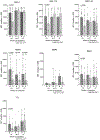Are high avidity antibodies to Plasmodium falciparum antigens preferentially transferred across the placenta of premature and term babies?
- PMID: 37515848
- PMCID: PMC10528449
- DOI: 10.1016/j.placenta.2023.07.011
Are high avidity antibodies to Plasmodium falciparum antigens preferentially transferred across the placenta of premature and term babies?
Abstract
Introduction: Transplacental transport of maternal IgG via the neonatal Fc receptor (FcRn) provides babies with passive immunity. Several factors are reported to influence transport, including the avidity of antibodies (Abs) for their cognate antigens. Unfortunately, information on the role of antibody (Ab) avidity is limited. This study investigated if i) antibodies (Abs) with high avidity for 6 Plasmodium falciparum antigens and tetanus toxoid (TTx) were preferentially transferred to premature and term Cameroonian babies and ii) if Ab avidity was increased in babies whose mothers had placental malaria (PM), implicating the involvement of immune complexes.
Methods: Total IgG (mg/ml) and Abs to malarial antigens (AMA1, EBA-175, MSP1-42, MSP2, MSP3, DBL5 of VAR2CSA) and TTx were measured in paired mother-cord samples obtained from premature and term deliveries in Cameroon. Half the women had PM at delivery. Avidity Indices (AIs) were determined by treating antigen-bound-Abs with different molar concentrations of NH4SCN and calculating 50% endpoints.
Results: Total IgG and antigen-specific Abs increased in cord blood with gestational age; however, AIs did not. AIs in paired maternal-cord blood samples were strongly associated for all antigens (r = 0.77-0.96). However, no significant different in AIs was found between paired mother-cord blood samples for any of the antigens (p values > 0.05). Similarly, Ab avidity was not increased in cord blood of babies whose mothers had PM or hypergammaglobulinemia.
Discussion: Overall, there was no evidence that higher avidity Abs to any of the malarial antigens or TTx were preferentially transferred to Cameroonian babies.
Keywords: Antibody avidity; FcRn; Malaria; Maternal IgG; Transplacental transfer.
Copyright © 2023 Elsevier Ltd. All rights reserved.
Conflict of interest statement
Declaration of competing interest All authors declare they have no real or perceived conflict of interests.
Figures



References
-
- Yeung C, Hobbs J, Serum-γg-globulin levels in normal, premature, and “small-for-dates” newborn babies, The Lancet. (1968) 1167–1170. - PubMed
Publication types
MeSH terms
Substances
Grants and funding
LinkOut - more resources
Full Text Sources

